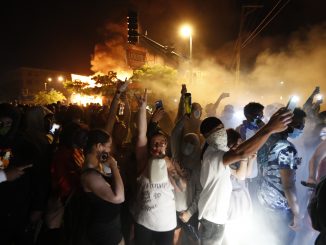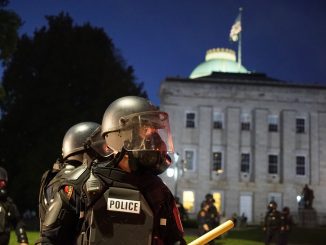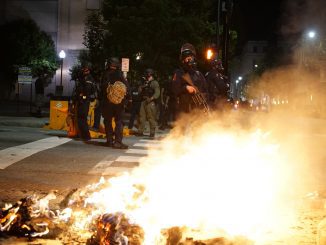
 Give Politico’s chief Washington correspondent, Ryan Lizza, some credit. After Michelle Obama’s speech capped the first night of the Democrats’ virtual convention, he tweeted: “Story of an era in two convention speeches: Barack 04: ‘There’s not a black America and white America. … There’s the United States of America.’ Michelle 20: ‘my message won’t be heard by some people’ because ‘we live in a nation that is deeply divided.’”
Give Politico’s chief Washington correspondent, Ryan Lizza, some credit. After Michelle Obama’s speech capped the first night of the Democrats’ virtual convention, he tweeted: “Story of an era in two convention speeches: Barack 04: ‘There’s not a black America and white America. … There’s the United States of America.’ Michelle 20: ‘my message won’t be heard by some people’ because ‘we live in a nation that is deeply divided.’”
But who’s to blame? Democrats like to load all the blame on President Donald Trump, and, despite their continued failure to cite evidence for his “racism,” there’s no denying his coarse insults have contributed to an increasing sense of national division.
Balance that off, however — at least a bit — by recognizing that bipartisan electoral politics inevitably divide a citizenry, as it has ours since former President James Monroe was reelected without opposition in 1820. That Era of Good Feelings ended four years later when a four-candidate deadlock made the House decide the election. It’s been division ever since.
Then-Sen. Barack Obama’s 2004 speech made an Illinois state legislator into a plausible presidential candidate, an African American whose election promised to smooth over racial divisions as the election of John Kennedy in 1960 smoothed over Catholic-Protestant divisions. Such hopes buoyed Obama’s rapturous crowds from Denver’s Mile High Stadium to Berlin’s Tiergarten to Chicago’s Grant Park in 2008.
The letdown came well before Donald Trump descended that Trump Tower escalator in June 2015. Gallup showed the percentage of Americans rating black-white relations as very or somewhat good plunging in Obama’s second term, from 70% in 2013 to 51% in 2015. The 2014 exit poll showed 38% of voters believing “race relations in this country” had “gotten worse” in the last few years, versus 20% saying they’d “gotten better.”
Plainly, there was a sense of disappointment, of optimistic and perhaps unrealistic expectations being unmet. Comments by the president and his appointees about incidents in Ferguson, Missouri, and elsewhere probably contributed to this. But it surely also reflected continuing poor conditions and relatively high crime rates in many (not all) predominantly black neighborhoods.
Distinctions between Catholics and Protestants became less visible after 1960. Distinction between blacks and whites did not after 2008.
And politically, the Obama presidency left us in an America very sharply divided into two countries. Responses to COVID-19 have widened the already sharp partisan differences between big cities and the countryside. Democrats have vastly overestimated the virus’ death rate and its danger to people under 75, and have embraced stringent lockdowns and mandatory masking and social distancing. Republicans’ estimates have been closer to reality, and Republican states like Florida, Texas and Arizona have taken milder measures.
Partisan media (and Democratic convention scriptwriters) have hailed Democratic New York Gov. Andrew Cuomo despite his persistence in sending infected patients to senior citizen homes and the resulting high death rates. They’ve denigrated Republican Florida Gov. Ron DeSantis even though his 450 COVID-19 deaths per million is a fraction of New York’s 1,690.
There’s also a vivid contrast between the “mostly peaceful” (translated into English: often violent) demonstrations in hip Portland and Seattle; the criminal mobs in Minneapolis and Chicago; and the relatively calm and intact exurbs and small towns.
You could argue that Democrats’ extreme risk aversion and the resulting lockdowns have imposed hideous damage on Democratic turf. “New York City Is Dead Forever,” read a headline by Manhattan comedy club owner James Altucher. With restaurants, bars, museums and clubs closed down; storefronts up and down the avenues boarded up; and giant office buildings near empty, a de-policed Manhattan has been transformed from a garden into a combat zone. Zoom technology threatens to make unnecessary the face-to-face interactions that have always drawn professionals there.
Teacher’s union members’ refusals to return to school, despite overwhelming evidence that kids don’t get and don’t transmit the virus, may end up promoting school choice. Colleges and universities going virtual may demonstrate their dispensability.
The partisanship that has made Democrats shun (and Republicans embrace) hydroxychloroquine has made Democrats, even those thronging to Black Lives Matter demonstrations, much more determined to vote by mail — and prone to implausible U.S. Postal Service conspiracy theories. The actual problem, misstated by President Donald Trump, is that in many states, many ballots may be improperly filled out or not delivered on time. You can request a postal ballot in Michigan the Friday before the election. Good luck getting it delivered by Tuesday.
Democratic convention speakers are blaming Trump for not stamping out the virus, for the lockdowns’ economic devastation and for intensified partisan rancor. He’s made mistakes and missteps, but the charges are over the top. Maybe they’re an attempt to cover up the differences between red and blue America, which don’t work to Democrats’ advantage.
Michael Barone is a senior political analyst for the Washington Examiner, resident fellow at the American Enterprise Institute and longtime co-author of “The Almanac of American Politics.”



